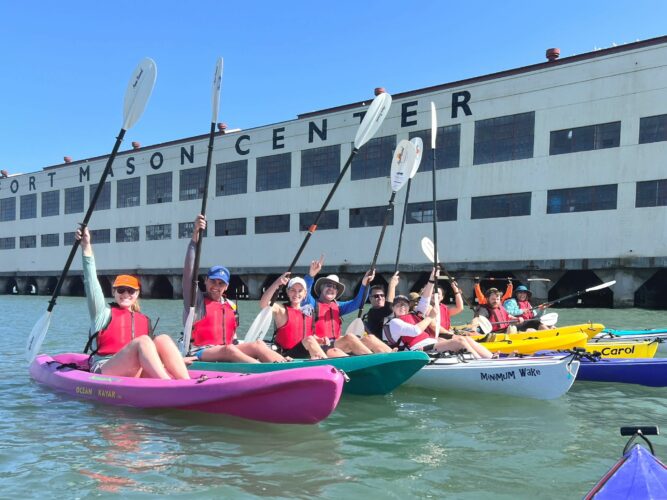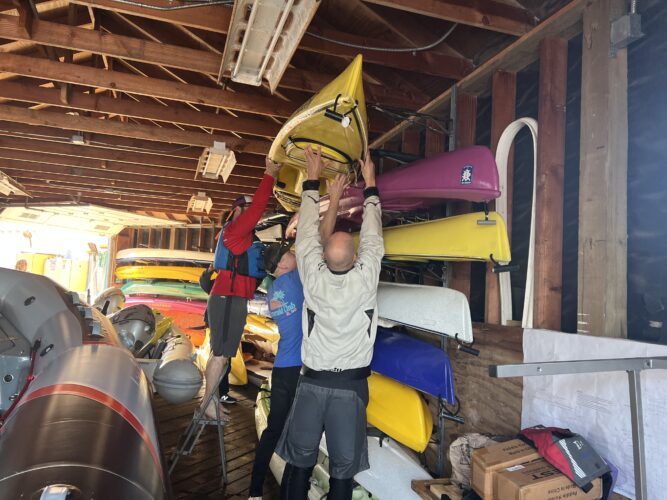An orientation is required before you may use a club kayak. Request Training Here
The orientation typically takes about 2 1/2 hours and will cover the following ground:
- Overview of our boats
- Club Procedures and Rules
- How to prepare and launch the boats. How to use the dock.
- We’ll paddle kayaking around the cove along with a capsize practice.
(Yes, you will get wet.) - Learn how to put away the boats correctly.

Once you’ve taken your orientation, you may use a club kayak any time in the cove. You may also accompany certified paddlers out of cove, and help pilot club swim events.
What to Wear
Kayaking is great fun, but only if you’re well dressed for the conditions. In most outings you’re unlikely to fall in, but you should be prepared for the possibility. Your bum will likely be in a puddle of water, you may be splashed with water from spray, and the wind can quickly make you cold. If you’re expecting to paddle hard, your body heat might keep you warm, but if you’re piloting swimmers at a slow place it’s easy to become cold.
…in Winter
In the winter months, the water can be cold in the low 50’s, and the air temperature is not much higher. Combine this with wind and you’ll quickly realize that you need to dress well.
A wetsuit is strongly recommended. It doesn’t need to be full length. Windproof smock/windbreaker. Windproof Pants. Layers. Polartec or smartwool shirt. Booties to keep your feet warm. More dependent on air temperature than water temperature. Wooly hat.
…in Summer
Summer months (June-Oct) are much more forgiving for kayakers. But still, we advise you wear layers of synthetic clothing with a waterproof top layer.
Preparation
A successful trip starts with good preparation:
- Sign out your kayak
The log book is at the podium in the main boathouse. - Check weather and currents
You will learn more about this in the Bay Safety course and during the in person lesson - Paddle
Paddles are kept beside the Boat Shed. - Life Vests – The club has a range of life vests available for use. For kayaking, we recommend you use standard (non-inflatable) vests that will keep you buoyant and keep you warm.
Our kayak fleet is stored in the boat shed. The main garage doors are unlocked during club hours. If you need the key, it should be hanging on the wall near the semi-circular bar beside the kitchen.
It takes two people to carry a kayak out. Some of the kayaks are high up on the racks and you’ll need to use the step ladder to reach them.

Before you launch your kayak perform a safety check:
- Scuppers – Most kayaks have ‘scuppers’ to allow water to drain out – check to see that your kayak has plugs in place; they may be in the front, back, side, or middle of the kayak.
- Hatch seals – If your kayak has hatches – check to make sure there is a seal under the hatch cover and that it is in good condition – check the hatch to make sure it fits properly and if it has straps that they have a snug fit.
- Damage / leaks? – Give the kayak an inspection to ensure there is no damage. If you see anything significant, please report it to the Boat Captain.
When you choose your kayak – ask for help with bringing it to your launch area (usually the beach) constant dragging or dropping the kayak will weaken the exterior and it may crack and leak.
Launching
Getting your kayak into the water should be fairly straightforward. Walk the kayak into the water until you are thigh deep, then sit into the kayak and paddle off.
Be careful on days where there are large waves breaking on the beach. On these days it is usually better to launch from the dock.
Exercises to Practice
- Paddle straight, stop, back up, draw stroke.
- How to turn
- How to brace
- Paddling backwards
- Drift to determine winds and current.
- To paddle push as well as pull. Low elbows.
- Paddling using the full body
Paddling Tips
Straight or Feathered Blades?
Where possible learn how to kayak a feathered paddle. It’s easier to get into the habit from the beginning than change a bad habit later on.
Here’s a great article from the NY Times on Paddling Form and Technique for Exercise
Capsize Practice
The Bay is cold and on a kayak you may find yourself taking an unexpected dip in the water. With our kayaks, this should not be a big deal, but you should practice how to recover before that happens
<< Make a video >>
- Stay calm.
- Stay up wind.
- Hold on to the paddle.
- Scooch up over the side
- Go to end of boat if really windy and no chance of getting back on the kayak or if you need to catch your breath.
Return & Wash Down
Bring the kayaks back up to the deck. It helps to take the kayak directly from the water to reduce the amount of sand in the boat. Rinse the sand off your boat before putting it away. Pull apart your paddle and rinse it.
It is not unusual for kayaks to take on some water when so when you finish your outing – drain the kayak for the next person.
Put boat and paddle back. Most kayaks are placed on the shelf based on size so try to place your kayak back in the same shelf location.
Help others do the same. Sign yourself back in.
